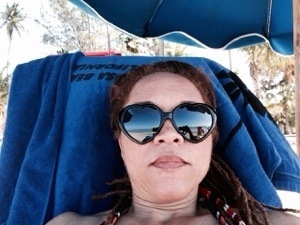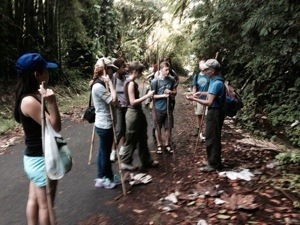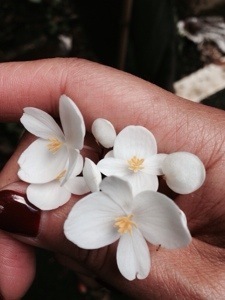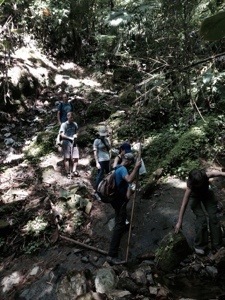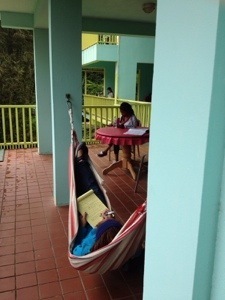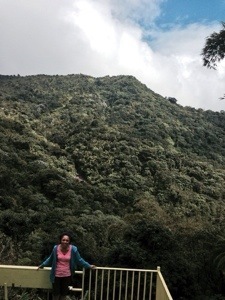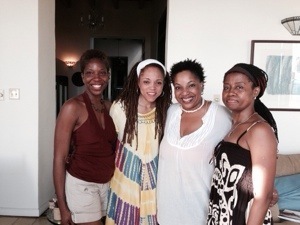Sophfronia Scott's Blog: Sophfronia Scott, Author, page 30
October 31, 2014
Who’s Afraid of Writing?
 In honor of Halloween I’m addressing the ghostly presence that haunts all writers: the blank screen/page. I haven’t thought about this specter for a while because I’ve spent the past few months submerged in a novel revision. However, last week I hit the SEND button, delivered the book to my agent, and unwittingly invited the spirit back to my desk. It’s time to begin again.
In honor of Halloween I’m addressing the ghostly presence that haunts all writers: the blank screen/page. I haven’t thought about this specter for a while because I’ve spent the past few months submerged in a novel revision. However, last week I hit the SEND button, delivered the book to my agent, and unwittingly invited the spirit back to my desk. It’s time to begin again.
I know certain writers would rather run screaming from the room than sit down and face that blankness. It’s hard, it’s frustrating, and yes, scary. But my family and close friends will tell you: I don’t do fear. It’s not that I don’t have fear—it’s quite present in fact. Sometimes it’s like a tiny badger on my shoulder, tugging at my dreadlocks in the most annoying way. I just don’t let the little bugger jerk me around by the hair all day. I believe in handling fear.
How do I do that? By constantly reminding myself fear is a complex emotion. It’s made up of many different worries and concerns. If I can get under the hood and see what’s broken, missing, or bothersome, I can address those issues and—poof!—dismantle the fear.
Here’s how it works. What is the fear of the blank screen really about? For some writers, it’s about a fear of writer’s block. And that block, depending on who you are, can be composed of a nasty brew of low self-esteem, lack of confidence, parental issues, and a host of other ghosties. 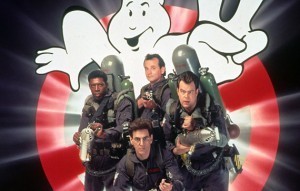 Choose one and bust away. If I’m blocked, I know it’s because something’s missing. I don’t know what to write because I haven’t done enough thinking, research, reading, planning, resting or something. I may not know what it is, but my plan of attack is to figure out what’s missing, fill the void, then get back to writing. I’m pretty good at that. Trust me, my screen won’t be blank for long.
Choose one and bust away. If I’m blocked, I know it’s because something’s missing. I don’t know what to write because I haven’t done enough thinking, research, reading, planning, resting or something. I may not know what it is, but my plan of attack is to figure out what’s missing, fill the void, then get back to writing. I’m pretty good at that. Trust me, my screen won’t be blank for long.
But recently I had a totally different writing/fear experience. The final stages of this novel revision kicked my butt. Even though I knew what I was doing with it—I even had a list of to-dos I was working my way through—there were times when I was afraid I would never be done. I had this sense A LOT in the past month. If I had let that fear stop me on any given day, I would have ensured the non-finish of this novel.
So I had to break it down. What was my fear really about? And what could I do about it? Here’s what I found and what I did. I decided the issues goring me most were frustration and isolation.
Frustration
This was really the heart of the matter. I would think I had one chapter to write and it would become two. Then I had to go back to the beginning and make changes to accommodate the new material. I felt like Mickey Mouse trying to destroy those broomsticks in The Sorcerer’s Apprentice only to have them keep multiplying. The work always seemed to increase not decrease. Fortunately, thanks to an excerpt in Narrative Magazine, I discovered words of comfort in Memorable Days: The Selected Letters of James Salter and Robert Phelps. I devoured the whole book, especially Salter’s 1972 letters describing his writing of the manuscript that became the novel Light Years. I felt as though we shared the same struggles:
I felt like Mickey Mouse trying to destroy those broomsticks in The Sorcerer’s Apprentice only to have them keep multiplying. The work always seemed to increase not decrease. Fortunately, thanks to an excerpt in Narrative Magazine, I discovered words of comfort in Memorable Days: The Selected Letters of James Salter and Robert Phelps. I devoured the whole book, especially Salter’s 1972 letters describing his writing of the manuscript that became the novel Light Years. I felt as though we shared the same struggles:
 “I’m on page 115 (of my own book). I hardly remember what is behind me. It’s like a densely enacted journey during which you’ve made notes. When I’m finished with this first, tedious working-out, in the summer, I’m going to look at it like a ruined garden, I hope I will, with dimensions that please, lovely corners, walls, and weeds, weeds everywhere…”
“I’m on page 115 (of my own book). I hardly remember what is behind me. It’s like a densely enacted journey during which you’ve made notes. When I’m finished with this first, tedious working-out, in the summer, I’m going to look at it like a ruined garden, I hope I will, with dimensions that please, lovely corners, walls, and weeds, weeds everywhere…”
And when Salter had his breakthrough, I knew mine couldn’t be far behind. Even now I still love reading these words:
“But a few minutes ago, searching for the place to insert an anecdote about marriage I’d heard, a place in my manuscript which is now almost 300 pages, I had a wonderful thing happen to me, I suddenly realized: it’s there! I had begun to read and I saw that I liked it, even more, I was completely taken by it, and also, for the first time I caught that faint glimmer that is light at the end of the tunnel. To think that this will be a book, and a book that I am deeply interested in, what comes from the vitals, as Kazantzakis said. Suddenly I am filled with energy.”
Isolation
I don’t write in total isolation. I’m lucky to have a writing partner, the excellent author David Hicks who lives in Colorado but meets me via Google Hangout for several hours each week and we write in each other’s company like two people sharing an office. But as I neared the end of my revision I felt my world had become vastly constricted. I couldn’t see beyond getting my family fed, my son to school, and working on my book. As time went on my hair grew down to my hips, I stopped writing to friends, weeds overtook my yard, and rooms in my house disappeared under clutter and laundry. I started to feel like a wild woman alone in the forest and feared I would not find my way back.
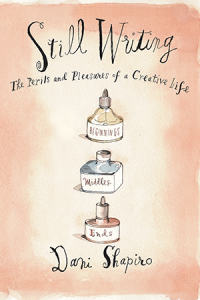 But I happened to pick up Dani Shapiro’s Still Writing: The Perils and Pleasures of a Creative Life and learned this was okay. She too, while finishing a book, let her hair grow long, lost touch with friends, didn’t clean windows. And in this she gave me permission to take care of myself and my book through this final push.
But I happened to pick up Dani Shapiro’s Still Writing: The Perils and Pleasures of a Creative Life and learned this was okay. She too, while finishing a book, let her hair grow long, lost touch with friends, didn’t clean windows. And in this she gave me permission to take care of myself and my book through this final push.
“I took care of my family, and my book got written. That was all I could manage…As you near the end, you will likely feel selfish. You will want to do everything you can to protect your instrument—which is to say, yourself—as you inch toward the finish line. This is as it should be, as it must be, if your work is to reach its potential. Embrace this selfishness, for now. Wrap it around you like a quilt made of air. Let no one inside of it except those you love the most. Don’t leave that essential place. Be a good steward to your gifts.”
 Dani’s wonderful words told me I wasn’t alone, and this time would soon pass. Even more, I will probably enter this phase again with the next book. But I’ll recognize it next time, and be a little less floored. As I came back into the world I had the opportunity to meet the lovely Dani in person and thank her for easing me through this revision and the fear. I’ve learned the light at the end of the tunnel often is people like Dani Shapiro and James Salter showing the way.
Dani’s wonderful words told me I wasn’t alone, and this time would soon pass. Even more, I will probably enter this phase again with the next book. But I’ll recognize it next time, and be a little less floored. As I came back into the world I had the opportunity to meet the lovely Dani in person and thank her for easing me through this revision and the fear. I’ve learned the light at the end of the tunnel often is people like Dani Shapiro and James Salter showing the way.
What do you do to handle your writing fears?
xo
July 8, 2014
My VCFA Graduation Speech
On Saturday, July 5, I graduated from Vermont College of Fine Arts with my MFA in Writing, fiction and creative nonfiction. My classmates chose me to deliver an address. I wanted very much to do them proud. Here’s the video. Since my talk is all about creativity and connection I hope you can take something useful from it too.
May 14, 2014
My Writing Process – Blog Tour
Picture a group of writers. We’re on a bus. No, we’re not singing Elton John’s “Tiny Dancer” like they do in the movie Almost Famous but we are traveling great distances and having fun. We stop at the virtual internet residence of each writer and there he or she introduces the people they know to the writers on the bus. It’s a wonderful trip because readers get to learn about new authors and their books, and the writers get to connect with new readers. That’s what the My Writing Process Blog Tour is all about. So this week is my stop and I’m happy to introduce you to a few excellent and fierce writers on my radar.
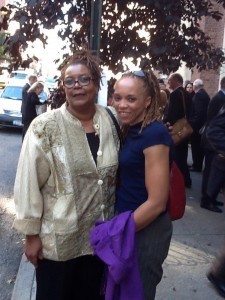 My friend Breena Clarke invited me—I will forever crow to the rooftops about her! Breena and I met when we both worked at Time Magazine. While still at Time she was laboring on her first novel that eventually became the Oprah Book Club smash hit, River, Cross My Heart. Her second novel is Stand the Storm and her third will be published in July: Angels Make Their Hope Here. (Isn’t that an awesome title?)
My friend Breena Clarke invited me—I will forever crow to the rooftops about her! Breena and I met when we both worked at Time Magazine. While still at Time she was laboring on her first novel that eventually became the Oprah Book Club smash hit, River, Cross My Heart. Her second novel is Stand the Storm and her third will be published in July: Angels Make Their Hope Here. (Isn’t that an awesome title?) 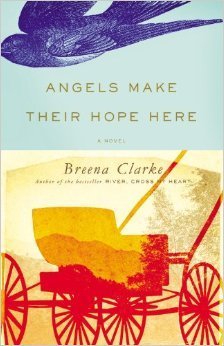 I’ve heard Breena read from this book and it is stunning. You can pre-order it now and I enthusiastically suggest you do so.
I’ve heard Breena read from this book and it is stunning. You can pre-order it now and I enthusiastically suggest you do so.
Breena is also the co-founder, along with her sister, the poet Cheryl Clarke, of the Hobart Book Village Festival of Women Writers. I had the privilege of teaching at the first festival and the second is coming up in September. Please check it out. You can also help support this excellent event by going here and participating in the fundraising campaign.
Now, to answer the four questions all writers on the blog tour answer:
What am I working on?
 I have a few projects underway including the revision of my second novel, The Light Lives Here. I’m also working on a collection of memoir essays and I’ve written a book proposal for a memoir, Eyes in My Fingertips, that I will co-author for a Harvard classmate who has been blind since birth. All this is going on as I finish the work of my final semester at Vermont College of Fine Arts. I’m graduating with an MFA in writing, fiction and creative nonfiction, on July 5.
I have a few projects underway including the revision of my second novel, The Light Lives Here. I’m also working on a collection of memoir essays and I’ve written a book proposal for a memoir, Eyes in My Fingertips, that I will co-author for a Harvard classmate who has been blind since birth. All this is going on as I finish the work of my final semester at Vermont College of Fine Arts. I’m graduating with an MFA in writing, fiction and creative nonfiction, on July 5.
How does my work differ from others of its genre?
I’m not sure how I compare with other writers in my genres (historical fiction, essay, memoir), but I know what makes me stand out as a writer. In fact I had this conversation the other night with a friend who had just read an essay of mine. The essay was recently named a finalist in a creative nonfiction contest. (This isn’t public yet–I’ll announce the details when the literary journal publishing my essay does so.) Anyway, my friend’s comments, I think, sum up how I am with all of my writing:
“I love the emotion and risk you put into your writing.”
“This is brilliant. Truly heartfelt, emotional, real, inspirational, and quality.”
“How many writers spill their blood on the page with such trust and gusto knowing their audience needs to hear these words, these messages from their heart?”
If that sounds intense, I suppose it’s because I am an intense writer. I put a serious amount of love into my work with the hope that a lot of love will come out for the reader on the other side. When such love is involved it’s hard for the product to do anything but burn—burn with joy, burn with wonder, burn with gratitude.
Why do I write what I do?
 In the movie Chariots of Fire, the character of the Olympic runner Eric Liddell, as portrayed by Ian Charleson, talks about running being his God-given talent. “God made me fast,” he says. “When I run I feel His pleasure.” It’s like that with me and writing. I feel I’ve got to do the thing I’ve been blessed to have this gift to do. And it’s exhilarating when I know I’m writing well because I too feel His pleasure. I know only good can come of the work even if only one other person reads it. I watch Chariots of Fire whenever I need a jolt of inspiration, which I did only yesterday in fact.
In the movie Chariots of Fire, the character of the Olympic runner Eric Liddell, as portrayed by Ian Charleson, talks about running being his God-given talent. “God made me fast,” he says. “When I run I feel His pleasure.” It’s like that with me and writing. I feel I’ve got to do the thing I’ve been blessed to have this gift to do. And it’s exhilarating when I know I’m writing well because I too feel His pleasure. I know only good can come of the work even if only one other person reads it. I watch Chariots of Fire whenever I need a jolt of inspiration, which I did only yesterday in fact.
How does my writing process work?
In this last semester of my MFA program I’ve been working on my novel under the guidance of another talented writer/teacher, Bret Lott. He asked me about my process—he seemed fascinated by the placeholders and notes to myself I had scattered throughout the manuscript. This is how I explained it all to him:
I’m very much a story-minded novel writer—I want to make sure I have a strong, multi-layered story that can be sustained over 300 or more pages. I think about who my characters are, what they want, and how to create a dramatic arc for them over the course of the novel’s pages. First I think of my big picture story, then I figure out what my climax point is and I aim for that. I try to know my beginning and ending, and I’m fully aware both might change during the process. I will make an initial list of chapters and then a list of what needs to happen in each chapter to move the story forward—yes, I’m an outliner.
Once I know where I’m going I start writing. Some scenes do come more easily than others, but it’s really a matter of my brain being able to focus on one chapter for a good amount of time. And as much as I try to write on the computer it always seems my best stuff is written by hand on a legal pad with a black gel pen.
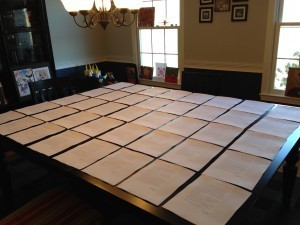 After I get a draft written, that’s when I can see the holes, what’s missing in the manuscript. It could be details, description, plot points—items both minor and major. Some can be fixed with a sentence or two. Some will require whole chapters be added. I put notes or placeholders in the pages so I can see what belongs where and to remind myself of what needs to be done. I keep revising in this way until I feel the book is complete. This is what I’m doing now with my novel—I’m on the third draft. Here it is laid out on my dining room table.
After I get a draft written, that’s when I can see the holes, what’s missing in the manuscript. It could be details, description, plot points—items both minor and major. Some can be fixed with a sentence or two. Some will require whole chapters be added. I put notes or placeholders in the pages so I can see what belongs where and to remind myself of what needs to be done. I keep revising in this way until I feel the book is complete. This is what I’m doing now with my novel—I’m on the third draft. Here it is laid out on my dining room table.
So I guess as a writer I’m organized and kind of technical. Perhaps this structure is what gives me the freedom to take risks and be emotional. It’s all part of the whole!
Passing the Baton
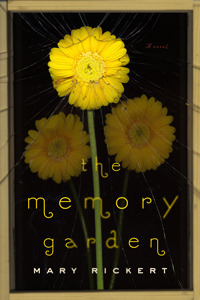
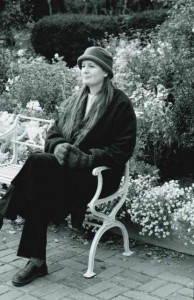 I’d love for you to meet Mary Rickert! She too earned her MFA from Vermont College of Fine Arts. She’s also worked as a kindergarten teacher, coffee shop barista, Disneyland balloon vendor and personnel assistant at Sequoia National Park (How cool is that?). She now lives in Cedarburg, Wisconsin, a small city of candy shops and beautiful gardens. She has published numerous short stories and she won a Shirley Jackson Award for her story, “The Corpse Painter’s Masterpiece.” Her first novel, The Memory Garden, a magical realist story of women’s secrets and friendships was published this month. She’ll publish her blog post at www.maryrickert.com May 21.
I’d love for you to meet Mary Rickert! She too earned her MFA from Vermont College of Fine Arts. She’s also worked as a kindergarten teacher, coffee shop barista, Disneyland balloon vendor and personnel assistant at Sequoia National Park (How cool is that?). She now lives in Cedarburg, Wisconsin, a small city of candy shops and beautiful gardens. She has published numerous short stories and she won a Shirley Jackson Award for her story, “The Corpse Painter’s Masterpiece.” Her first novel, The Memory Garden, a magical realist story of women’s secrets and friendships was published this month. She’ll publish her blog post at www.maryrickert.com May 21.
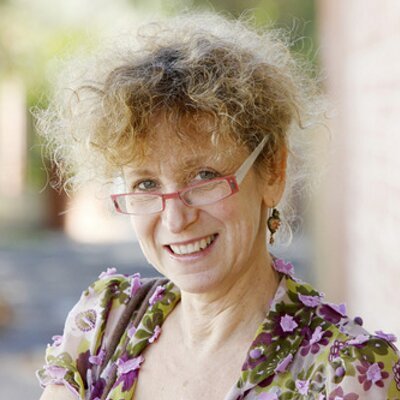 Next I take you to the other side of the world—Australia!—to introduce to you the physician and writer Leah Kaminsky. This busy lady, another VCFA graduate, serves as Poetry & Fiction editor at the “Medical Journal of Australia” as well as online editor at “Hunger Mountain.” She’s authored several books and her novel, The Waiting Room, will be published by Random House Books AU in 2016. Her blog post will be up at www.leahkaminsky.com.
Next I take you to the other side of the world—Australia!—to introduce to you the physician and writer Leah Kaminsky. This busy lady, another VCFA graduate, serves as Poetry & Fiction editor at the “Medical Journal of Australia” as well as online editor at “Hunger Mountain.” She’s authored several books and her novel, The Waiting Room, will be published by Random House Books AU in 2016. Her blog post will be up at www.leahkaminsky.com.
That’s all! Hope you’ve enjoyed this leg of the ride.
Cheers,
Sophfronia
April 17, 2014
My Next Creativity Playdate
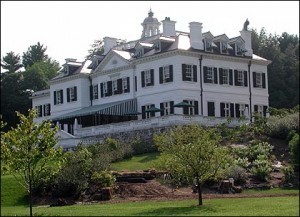 I’ve had a house on my mind. I’m writing something requiring me to conjure the environment of a grand home, a mansion. I feel the need to walk through the expansive rooms of such a place and to roam the blooming, well-tended gardens of a glorious property. When I expressed this thought to my husband he said, “Wasn’t there a writer somewhere around here with a house like that? Somebody with an E name like Eudora.” I felt like I’d been pinched awake. “You mean Edith! Edith Wharton!” I said.
I’ve had a house on my mind. I’m writing something requiring me to conjure the environment of a grand home, a mansion. I feel the need to walk through the expansive rooms of such a place and to roam the blooming, well-tended gardens of a glorious property. When I expressed this thought to my husband he said, “Wasn’t there a writer somewhere around here with a house like that? Somebody with an E name like Eudora.” I felt like I’d been pinched awake. “You mean Edith! Edith Wharton!” I said.
How could I forget? I once clipped an article from O, the Oprah Magazine about the restoration of The Mount, the home Edith Wharton designed for herself in the early 1900s. It’s only 85 miles north of here in Lenox, Massachusetts. I wanted to shout “Road trip!”
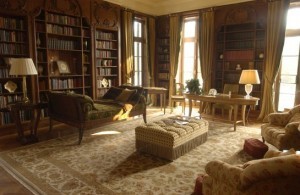 But when I went to the home’s website I learned it won’t open to the public for the season until May 3. That’s okay, I’ll go then. For now I’m contenting myself with photos of The Mount–look at her gorgeous library!–and reading the book Edith Wharton at Home: Life at The Mount by Richard Guy Wilson. In light of my recent post about creativity playdates and how I was in search of my next adventure, I wanted to let you know I’ve found it. I’m eager to see the place of which Wharton wrote so lovingly in her autobiography:
But when I went to the home’s website I learned it won’t open to the public for the season until May 3. That’s okay, I’ll go then. For now I’m contenting myself with photos of The Mount–look at her gorgeous library!–and reading the book Edith Wharton at Home: Life at The Mount by Richard Guy Wilson. In light of my recent post about creativity playdates and how I was in search of my next adventure, I wanted to let you know I’ve found it. I’m eager to see the place of which Wharton wrote so lovingly in her autobiography:
“On a slope overlooking the dark waters and densely wooded shores of Laurel Lake we built a spacious and dignified house, to which we gave the name of my great-grandfather’s place, The Mount…There for over ten years I lived and gardened and wrote contentedly, and should doubtless have ended my days there had not a grave change in my husband’s health made the burden of the property too heavy.
But meanwhile The Mount was to give me country cares and joys, long happy rides and drives through the wooded lanes of that loveliest region, the companionship of a few dear friends, and the freedom from trivial obligations which was necessary if I was to go on with my writing. The Mount was my first real home…its blessed influence still lives in me.”
I’ll happily report back after my visit and let you know how it inspired me.
April 2, 2014
The Importance of Creativity Playdates
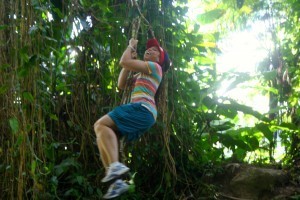 If you’re a writer and a parent (I am) you probably schedule or once scheduled many playdates for your children. When was the last time you booked one for yourself? I’m not talking about hanging out with your friends, (although you could include them in this adventure) I’m talking about a creativity playdate. This is time you set aside for yourself to do something that fills your well of inspiration. A creativity playdate can be simple and close to home—sitting in your favorite chair perusing gorgeous coffee table books. Or it could be a mini field trip that gets you out of the office and into a new environment: a trip to a museum or a public garden which would be ideal now because spring bulbs will soon bloom. It could even be a big trip: My recent Vermont College of Fine Arts study abroad residency in Puerto Rico was basically a huge creativity playdate with my fellow writing students.
If you’re a writer and a parent (I am) you probably schedule or once scheduled many playdates for your children. When was the last time you booked one for yourself? I’m not talking about hanging out with your friends, (although you could include them in this adventure) I’m talking about a creativity playdate. This is time you set aside for yourself to do something that fills your well of inspiration. A creativity playdate can be simple and close to home—sitting in your favorite chair perusing gorgeous coffee table books. Or it could be a mini field trip that gets you out of the office and into a new environment: a trip to a museum or a public garden which would be ideal now because spring bulbs will soon bloom. It could even be a big trip: My recent Vermont College of Fine Arts study abroad residency in Puerto Rico was basically a huge creativity playdate with my fellow writing students.
Creativity playdates are just as important as the time you schedule for writing. In fact, your writing time can be difficult and fruitless without them. If you find you spend much of your writing time staring wordless at the screen or blank page, you’re in need of a creativity playdate. Looking for a story idea? Ride the subway a few stops or go sit in a park and pay attention. Your next character might step on at West 66th Street, or stroll past you wearing a top hat and walking a fluffy Scottish terrier sporting blue booties on its paws. I know my writing eye is awakened every time I travel the 65 miles south to New York City and take in the energy and movement of a different environment. Suddenly my senses have new sights, sounds, and smells to process. It’s exciting.
 My other creative activities include watching the television show “Project Runway” because I like seeing a different kind of artist, in this case fashion designers, exercising his or her own brand of creativity. I also color in coloring books (my Harry Potter one is my favorite), visit museums such as the Metropolitan Museum of Art in New York City or the Bruce Museum in Greenwich, Connecticut, and tour the homes of famous artists/designers/writers. I love Philip Johnson’s Glass House in New Canaan, Connecticut, but I recently learned part of the chateau home of the essayist Montaigne is open to the public in Dordogne Village in France. I would love to see his office/library and view the exposed beams in the tower where Montaigne engraved some of his thoughts, including his famous question “’Que sais-je?” or “What do I know?”
My other creative activities include watching the television show “Project Runway” because I like seeing a different kind of artist, in this case fashion designers, exercising his or her own brand of creativity. I also color in coloring books (my Harry Potter one is my favorite), visit museums such as the Metropolitan Museum of Art in New York City or the Bruce Museum in Greenwich, Connecticut, and tour the homes of famous artists/designers/writers. I love Philip Johnson’s Glass House in New Canaan, Connecticut, but I recently learned part of the chateau home of the essayist Montaigne is open to the public in Dordogne Village in France. I would love to see his office/library and view the exposed beams in the tower where Montaigne engraved some of his thoughts, including his famous question “’Que sais-je?” or “What do I know?”
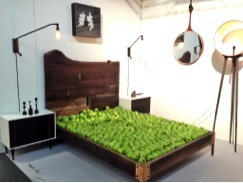 On my latest playdate I explored the Architectural Digest Home Design Show in New York City. It included art installations as well as design ideas and new home appliances and products. A bed of green apples caught my eye and sparked my imagination, as did a bizarre seating bench covered in tube-like purple velvet cushions entwined again and again. Mysterious and erotic!
On my latest playdate I explored the Architectural Digest Home Design Show in New York City. It included art installations as well as design ideas and new home appliances and products. A bed of green apples caught my eye and sparked my imagination, as did a bizarre seating bench covered in tube-like purple velvet cushions entwined again and again. Mysterious and erotic!
I encourage you to schedule a creativity playdate at least once a month. If you can’t think of something to do, consider this—you want to excite your five senses. Try to come up with ideas addressing each one. For example:
Smell: Explore perfume or incense shops; check out a store where you can sniff barrels of coffee beans, visit a florist.
Touch: Go to high-end stores or fabric shops where you can run your hands over rich materials or beautiful furniture. Take a cue from your childhood and visit a petting zoo or an aquarium that features touch tanks of specimens to hold.
Sight: Feast your eyes on works of art, or go on hikes to see spectacular views.
Sound: Attend concerts, plays, musicals, or sit in a place with lots of people where you can pick up pieces of overheard conversation.
Taste: Try a new cuisine by cooking a recipe you’ve never tried before or going to a different restaurant.
Really, you could do anything you want for your creativity playdate as long as you don’t forget to have fun! Let me know what you do or would like to do for your creative adventures. I might be in the market for a new idea this month. Thanks in advance!
January 9, 2014
VCFA Puerto Rico Residency Day 7
Posts from my Vermont College of Fine Arts winter residency.]
Here’s the thing: I can’t speak with any certainty about how the culture of Puerto Rico has influenced me. It’s just too soon. I probably won’t know until I embark on my next writing project and find myself infusing the work with the saltiness of codfish, the stickiness of thick, red rainforest mud, or the ethereal sadness of an angel’s face from the Santa Maria Magdalena de Pazzis Cemetery. But I have made some important discoveries, and I can discuss those here.
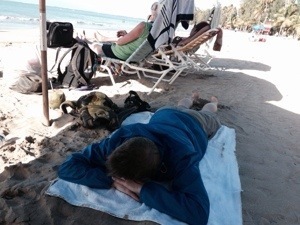 This is Raphe. He’s a poet and we will graduate together next summer, but we never met before at our previous residencies in Montpelier. In this photo he’s sleeping near my chair on Luquillo Beach. It may sound odd, but Raphe sleeping in my presence, usually while I’m writing in the common room of our shared villa, is the foundation of our new friendship. We appreciate the peaceful nature of each other’s personalities. I’ll come back to Raphe in a bit.
This is Raphe. He’s a poet and we will graduate together next summer, but we never met before at our previous residencies in Montpelier. In this photo he’s sleeping near my chair on Luquillo Beach. It may sound odd, but Raphe sleeping in my presence, usually while I’m writing in the common room of our shared villa, is the foundation of our new friendship. We appreciate the peaceful nature of each other’s personalities. I’ll come back to Raphe in a bit.
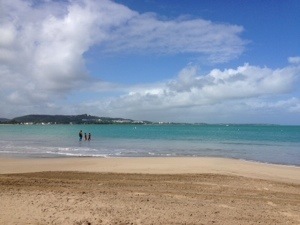 Our last full day in Puerto Rico began with a simple generative workshop using as writing prompts the concerns we voiced at the beginning of the residency. We had to choose one and use it as the first line of a poem or prose piece. The one I picked wasn’t my personal concern, but I thought it was interesting: “I’m scared of the rainforest.” Many of us worked on our pieces even as we awaited the time to load the vans for our journey to Luquillo Beach. Yes, this was the glorious day I’ve been waiting for–beach day!
Our last full day in Puerto Rico began with a simple generative workshop using as writing prompts the concerns we voiced at the beginning of the residency. We had to choose one and use it as the first line of a poem or prose piece. The one I picked wasn’t my personal concern, but I thought it was interesting: “I’m scared of the rainforest.” Many of us worked on our pieces even as we awaited the time to load the vans for our journey to Luquillo Beach. Yes, this was the glorious day I’ve been waiting for–beach day!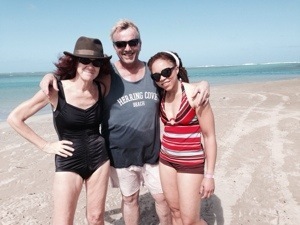 Five of our group went on a boating/snorkeling excursion, but I was done with adventure activities. I wanted to rent a beach chair and umbrella and sit and stare at the water, which is exactly what I did all day. Well, not quite– I went for a lovely walk on the beach with Richard McCann, Mary Ruefle, and fellow student Maggie Kast.
Five of our group went on a boating/snorkeling excursion, but I was done with adventure activities. I wanted to rent a beach chair and umbrella and sit and stare at the water, which is exactly what I did all day. Well, not quite– I went for a lovely walk on the beach with Richard McCann, Mary Ruefle, and fellow student Maggie Kast.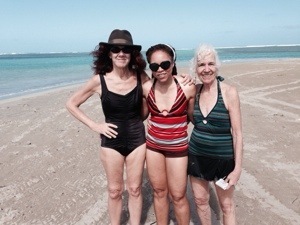
I spent some time soaking in the ocean. Saltwater draws out negative energies–yes, I do believe in such things! Then we walked down to the kioskos, little vendor storefronts in a long concrete structure, and found delicious food: oatmeal frappes (topped with whipped cream, 2 Oreo cookies and a vanilla wafer!), salted codfish, and plantains split down the middle and stuffed with spiced ground beef. Mary also found a kioskos that sold candy, but I had no room left in my stomach! 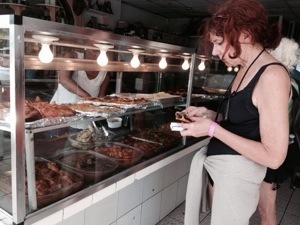
Our time on the beach was deeply satisfying because it was more time spent simply talking–about compassion, parenting, developing your own voice in a narrative, and where a person might be meant to live in the world. We could have stayed there well into the evening, but Luquillo Beach closed at 5pm–much too soon for me. The day melted away so fast. 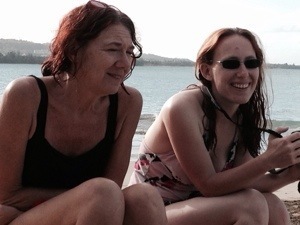
When we returned we held our celebratory dinner where we thanked Pam Taylor for being an awesome coordinator, and Carmen who cooked our amazing meals at Casa Cubuy. We also went around the room and responded to two questions: What did the trip teach us that was new? What did the trip remind us of that we already knew, but had lost or forgotten? 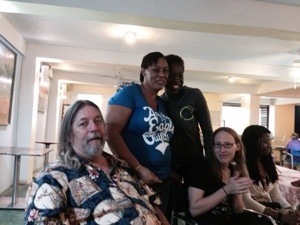
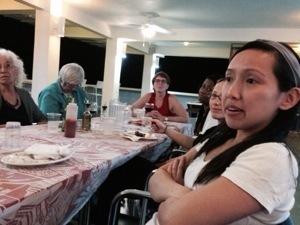
Here are my two responses:
My “new” thing I learned was that I could write daily about a current travel experience. I’ve never been able to do that before–in fact I’ve taken blank journals on trips for the purpose of chronicling my adventure only to return home with the book empty. While I may not be able to immediately process Puerto Rico’s influence on me, I suspect what I’ve written this week will help me recognize the seeds this culture has planted within me when they begin to sprout.
And my reminder? That brings me back to Raphe. I remembered I am a peaceful person, and that peace can be a comfort to myself and others. I forget this sometimes because, though I regularly sit in prayer and meditation, I don’t always get to see the effects of my practice. If one exercises, you can see and feel the results in your increased stamina and muscle tone. It’s harder to understand the results of a contemplative practice which, I suppose, is why it’s so easy to let it go for periods of time. But Raphe’s unexpected and delightful friendship is a really nice affirmation and it helps me say this: I’ll keep praying and meditating. I’ll keep seeking. I will appreciate this aspect of myself more and not take it for granted as I return to my home and family tomorrow. Thank you, Raphe.
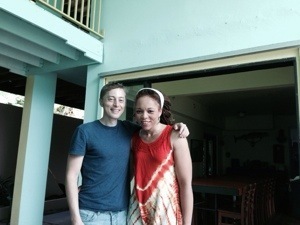
And thank you to our faculty, Richard McCann and Mary Ruefle. They were the best teachers, even more than I could have hoped for on this journey.
Thanks too to the rest of my fellow travelers/students: Daniel McGinn, Josephine Hughes, Partridge Boswell, Lillian Kwok, Brittany Rathbone, Shanalee Smith, Maggie Kast, Carolyn Walker, and Judith Ford.
Thank you for reading this, and journeying with me on this marvelous adventure. Take care and be well,
January 8, 2014
VCFA Puerto Rico Residency Day 6
Posts from my Vermont College of Fine Arts winter residency.
 Today we hiked into the rain forest in two groups-one for people with physical issues who would go on a less strenuous walk; the other for people able to make the challenging climb up to a huge waterfall. I joined the waterfall group and it was indeed challenging. We ended up scrambling over rocks and up through a kind of caged metal ladder–see the photo and you’ll know what I mean! We chewed on native plants such as tiny begonia flowers and little blueberries. We also examined the seed pods of orchids. Here are more photos. Truly a beautiful experience!
Today we hiked into the rain forest in two groups-one for people with physical issues who would go on a less strenuous walk; the other for people able to make the challenging climb up to a huge waterfall. I joined the waterfall group and it was indeed challenging. We ended up scrambling over rocks and up through a kind of caged metal ladder–see the photo and you’ll know what I mean! We chewed on native plants such as tiny begonia flowers and little blueberries. We also examined the seed pods of orchids. Here are more photos. Truly a beautiful experience!
Okay, yes, that’s me. Swinging on a vine. I highly recommend the activity.
This leaf (below) belongs to the trumpet tree. On the tree this leaf is green and bigger than your whole head. But after it falls its underside turns white and it has the feel of a thick paper bag. I wonder if it glows at night like slices of moonlight on the ground. 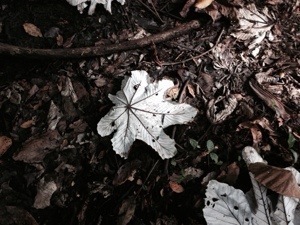

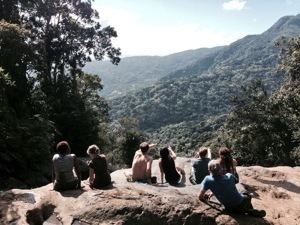
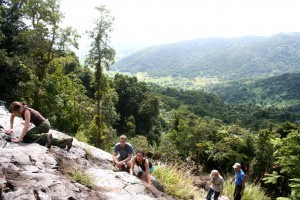
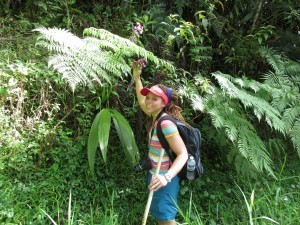
We started the hike around 10 a.m., ate sandwiches on the trail at lunchtime, and returned around 4:30. We still had a lecture to attend! I was tired, but the talk was worth it. Mary Ruefle took us on another kind of journey, through her notebooks. It was a great demonstration of a creative mind at work–wondering, questioning, challenging the stories, pieces of information, and teaching she encounters every day, especially as she reads.
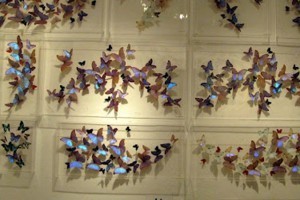 For instance, before we left Old San Juan she asked each of us to visit The Butterfly People, an art gallery featuring butterflies, dead and pinned, and arranged in thick plexiglass boxes that can be bought (small boxes for $40 and larger boxes for hundreds, even thousands of dollars) for hanging in your home. Mary described her experience of this gallery, of being stunned by the color and beauty of the butterflies while at the same time being uncomfortable, even angry, at where the gallery was getting the specimens. Were they truly grown on farms, as the owners told me when I asked, or were they obtained in a different way, possibly putting endangered species of butterflies at risk? Mary put this thought process in her notebook.
For instance, before we left Old San Juan she asked each of us to visit The Butterfly People, an art gallery featuring butterflies, dead and pinned, and arranged in thick plexiglass boxes that can be bought (small boxes for $40 and larger boxes for hundreds, even thousands of dollars) for hanging in your home. Mary described her experience of this gallery, of being stunned by the color and beauty of the butterflies while at the same time being uncomfortable, even angry, at where the gallery was getting the specimens. Were they truly grown on farms, as the owners told me when I asked, or were they obtained in a different way, possibly putting endangered species of butterflies at risk? Mary put this thought process in her notebook.
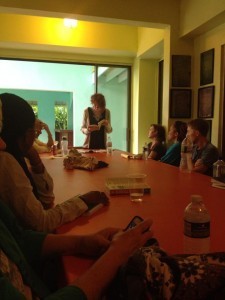 I feel Mary has the mind of a genius. I’m not sure people can appreciate her (but then when is genius ever really appreciated?) if they haven’t read her poems, essays, and lectures. (She read us a brilliant essay on shrunken heads earlier this week.) But can people appreciate the pieces if they never get to experience the whole? If you want to explore pieces of Mary, I recommend her book, Madness, Rack, and Honey, a compilation of her lectures.
I feel Mary has the mind of a genius. I’m not sure people can appreciate her (but then when is genius ever really appreciated?) if they haven’t read her poems, essays, and lectures. (She read us a brilliant essay on shrunken heads earlier this week.) But can people appreciate the pieces if they never get to experience the whole? If you want to explore pieces of Mary, I recommend her book, Madness, Rack, and Honey, a compilation of her lectures.
I hope you enjoy the photos from our hike. Tomorrow–beach day!
Until then,
January 7, 2014
VCFA Puerto Rico Residency Day 5
[Posts from my Vermont College of Fine Arts winter residency]
Today seemed to be about risk, on the page and in real life.
In the morning we assembled for a generative workshop, a session where we would create new work, possibly inspired by a writing prompt. I’m not a fan of prompts, but I’ve learned to be open and patient in such workshops. I know good work can come of them– one of the essays in my creative thesis was born of a writing prompt I received at the River Pretty Writers Retreat last year. So I was prepared to be game for this workshop. 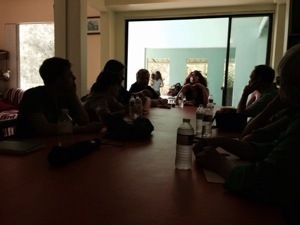
We read out loud an essay by Dorothy Allison, “Survival is the Least of My Desires,” in which she states upfront: “I believe the secret in writing is that fiction never exceeds the reach of the writer’s courage. The best fiction comes from the place where the terror hides, the edge of our worst stuff. I believe, absolutely, that if you do not break out in that sweat of fear when you write, then you have not gone far enough.”
So…I guessed we wouldn’t be generating happy essays about coqui in the rain forest.
This brought me to the moment of choice–would I be participating fully in the writing prompt to come, which Richard McCann already said would be a prompt we could write from for the rest of our lives? Or would I simply ignore the prompt and write whatever I wanted to write? Either way I would be taking a risk. If I dove into my worst stuff would I be able to really write and share what might come? If I didn’t do the prompt I would have to account for why if called on to share what I had written. I’ll give you the prompt first and tell you what I did.
The prompt came from this part of Allison’s essay in which she speaks of urging young writers “to confront their own lives in their fiction. Not that they must write autobiography, but that they must use the whole of their lives in the making of the stories they tell; they must honor their dead, their wounded and lost…”
Richard asked us each to make a list of “your dead, your wounded, your lost.” Then we had to circle the name for which we had the most energy and start writing about it. As we wrote, Mary Ruefle would call out a word and we had to incorporate that word into what we were writing. The words eventually totaled 16 and we had to use at least half of them. If you’re curious, here’s the list of words:
Sea
Artichoke
Purple
Sign
Transfix
Carpet
Words
Frond
Snap
Central
Born
Unheard of ever
Uninspected
Beverage
Divigate
I admit I didn’t get to half. I used 4, maybe 5 of the words. Reason being I was taking the first part of the assignment seriously, writing in a way to honor the person from my list. The words eventually became a distraction. I wrote them down to consider another time. As it turned out, we didn’t have to share what we wrote and I was glad. I felt the writing was risk enough. The sharing, like the word list, would only distract me from what was still taking shape on the page. For the same reason I can’t share with you what I worked on, but know this: I sought to be honest and honorable and I hope to continue to do so as I work on this piece.
Fast forward to the afternoon, post lunch. We’ve planned a hike to see petroglyphs, images carved into rocks by the native Taino people. But our guide arrives and there’s a hitch–the rain has swollen the river in the spot where we are to cross it. We have to swim across at a point where the water is about 8 feet deep. The guide described the distance across the river as short so I change into my swimsuit. I am not a strong swimmer, but I figured I could stroke well enough to get across. I thought this could be one of those life changing experiences where you do the thing you thought you couldn’t do. I wanted to try.
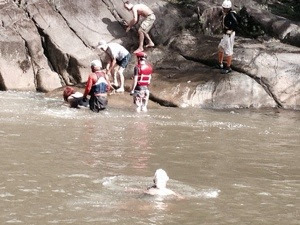 When we arrived, though, I found the river wider and the current strong because it was between two waterfalls. One couldn’t swim straight across because the current could take you over the rocks. You had to swim at an angle, making the effort harder and longer. When I saw these conditions I decided to pass. It was a risk I neither wanted nor needed to take. I am grateful I know my abilities and limitations. I didn’t feel bad about sitting on the rocks in the sun, which I enjoyed, as I waited for my fellow writers to return.
When we arrived, though, I found the river wider and the current strong because it was between two waterfalls. One couldn’t swim straight across because the current could take you over the rocks. You had to swim at an angle, making the effort harder and longer. When I saw these conditions I decided to pass. It was a risk I neither wanted nor needed to take. I am grateful I know my abilities and limitations. I didn’t feel bad about sitting on the rocks in the sun, which I enjoyed, as I waited for my fellow writers to return.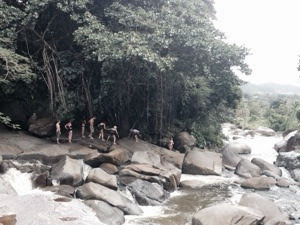
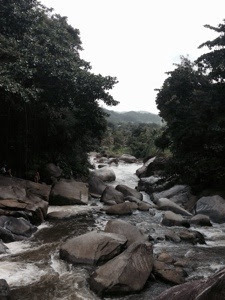
We held our last set of student readings tonight (I read my essay, “White Shirts”) which means we ‘re that much closer to the end of this residency. We still have three more days, though, so I won’t linger on that.
Big hike tomorrow!
Until then,
Sophfronia
January 6, 2014
VCFA Puerto Rico Residency Day 4
[Posts from my Vermont College of Fine Arts winter residency]
The music around us has changed. We’ve gone from the happy band sound of the Three Kings celebrations in old San Juan (think the Fiesta Trio from Dora the Explorer) to a chorus of crickets and coqui singing to us from the depths of the El Yunque rain forest. The coqui is a tiny tree frog named after its own persistent chirping sound. In the city I only heard one and he seemed to be in the same tree each evening. Here we get the harmonic effect of a multitude.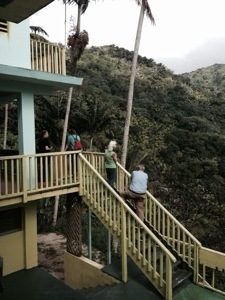
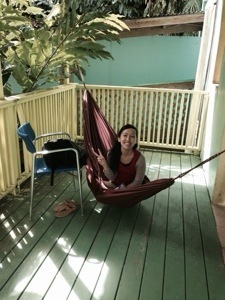
We’re staying at Casa Cubuy, a little resort lodge perched on the side of a mountain. While there are tourists here they are few in number–I admit I’m relieved after the crowds in the city. I also like the food they are feeding us here: authentic dishes of fish, rice & beans, sweet plantains, avocado salad, and a gorgeous chicken soup with yummy balls of carrot and potato so soft they melted deliciously on the tongue. Outside, plants that I’m used to seeing in nursery pots in Connecticut grow wild and large in their natural tropical habitat–coleus and poinsettia as tall as a small child. 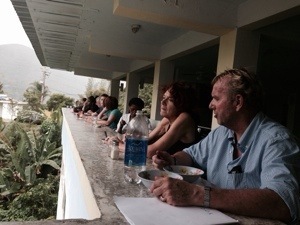 After arriving and getting settled our schedule today was simple: lunch, workshop, dinner, then readings by faculty members Richard McCann and Mary Ruefle and our coordinator/graduate assistant Pam Taylor.
After arriving and getting settled our schedule today was simple: lunch, workshop, dinner, then readings by faculty members Richard McCann and Mary Ruefle and our coordinator/graduate assistant Pam Taylor.
By the way, it does rain in the rain forest but not in the way I thought it would. I thought we would have one or two rainy days. In fact we have 6 or 7 rainy intervals throughout the day lasting about 10 minutes each. It’s like a cloud arrives, wrings itself out over us, then moves on and the sun returns. As we held workshop on a terrace a grand rainbow arched over the forest below us. Mary took it as a good sign. 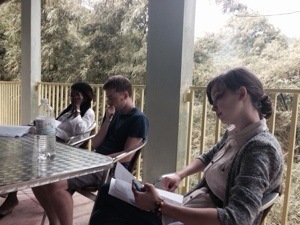
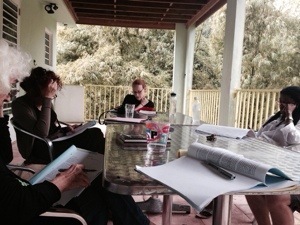
And now that we’ve come to Mary, here are today’s workshop tidbits:
“You want to find a stanzaic order that cannot be shifted without something being lost.”
“The parts of the poem don’t talk to the reader. They talk to each other. If you can get the parts to talk to each other, the poem will talk to the reader. ”
“A poem is words, punctuation, and space on the page.”
“Sometimes your worst enemy is being conscious that you’re writing a poem.”
“When you write seriously you’re committed to growing.”
That’s all for now. Tonight I’m tired and looking forward to a good long sleep. I’ll let you know if the crickets and coqui keep me awake.
January 5, 2014
VCFA Puerto Rico Residency Day 3
[Posts from my Vermont College of Fine Arts winter residency.]
The author Yolanda Arroyo Pizzaro dabbed at the tears in her eyes with Kleenex as she asked the question: “Who will be the leader, the great writer who will tell these women’s stories?” Yolanda is a local writer (in 2008 she was chosen as one of the most important Latin American writers under 39) who visited with us today to talk about her work. The depth of emotion she displayed while speaking told me what it means to write with something at stake. She was talking about narratives of Puerto Rican slave women–stories that have gone unwritten and untold for centuries. On the mainland U.S. slave narratives have been part of our history–most children learn the story of Harriet Tubman in school for instance–but in Puerto Rico that hasn’t been the case. Yolanda passed around a paperback copy of a book she bought at a conference, Memorias de Lucia. Until recently it was the only book about a woman’s personal experience of slavery in Puerto Rico. “I resent that,” she said. “I resent that.”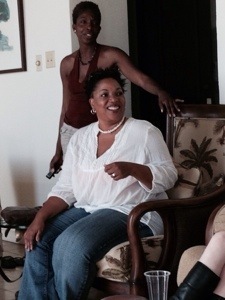 Yolanda proceeded to go through a list of women slaves for whom some information existed. Some if them were even leaders in slave rebellions. When she finished we had counted 22 women. Yolanda pointed out she has told three of their stories in her short story collection, Negras. “Who will tell their stories?” She asked. “These women want to talk.” I wonder if I can tell one of them? I plan to connect with Yolanda when I get home, go over her list again and see what comes out for me. Such a weighty challenge–can I carry it with the same passion and grace she has? Or will it turn out to be a crusade that doesn’t capture my spirit because it is not my own?
Yolanda proceeded to go through a list of women slaves for whom some information existed. Some if them were even leaders in slave rebellions. When she finished we had counted 22 women. Yolanda pointed out she has told three of their stories in her short story collection, Negras. “Who will tell their stories?” She asked. “These women want to talk.” I wonder if I can tell one of them? I plan to connect with Yolanda when I get home, go over her list again and see what comes out for me. Such a weighty challenge–can I carry it with the same passion and grace she has? Or will it turn out to be a crusade that doesn’t capture my spirit because it is not my own?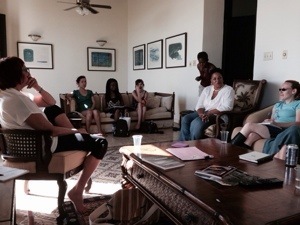 Yolanda began our talk with two questions and a writing exercise. The first question: Do you know the meaning of your name? “If you do,” she said, “it means you want to know about the world and you’re starting with the world around you–your origins. Everything you write comes from the origin of who you are.” The second question: Do you know the names of your father, mother, grandparents, great-grandparents and what they mean? “Look at that history,” she said. “If you don’t know it, a significant part of your poetry/writing will be missing.” She then invited us each to write a four-line poem about our names.
Yolanda began our talk with two questions and a writing exercise. The first question: Do you know the meaning of your name? “If you do,” she said, “it means you want to know about the world and you’re starting with the world around you–your origins. Everything you write comes from the origin of who you are.” The second question: Do you know the names of your father, mother, grandparents, great-grandparents and what they mean? “Look at that history,” she said. “If you don’t know it, a significant part of your poetry/writing will be missing.” She then invited us each to write a four-line poem about our names.
When I came to Puerto Rico I expected to be influenced by the colors, food, and tropical feel of this island. I didn’t realize I would find such a passion for writing. And it’s not the “Oh, I love to write” I’m talking about. Authors such as Yolanda and Hector from yesterday have a deep appreciation for the gravity of writing, for how meaningful it is to produce the written word. They remind me of the Edwidge Dandicat book I read last year, Create Dangerously. How would our writing change if we chose to create with the passion of these Puerto Rican writers?
Workshop means more tidbits from Mary Ruefle! Here they are:
“Any poem is a configuration of a linguistic energy cycle. Energy is created and it is released. That’s what makes the act of reading a poem satisfying.”
“There’s a huge difference between what the poem is trying to say and what the author is trying to say. The author’s job is to listen to the poem”
“Let’s look at the houses we have built out of words on the page.”
Thank you Mary!
Tomorrow we leave Old San Juan to spend the week in the El Yunque rainforest. We may not have an internet connection there but if not, no worries. I’ll keep good notes and fill you in on our return.
Cheers,


